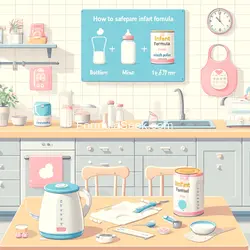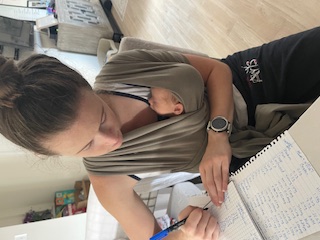
How to Safely Prepare Infant Formula: A Step-by-Step Guide
Step 1: Wash Your Hands
First things first, always wash your hands thoroughly with soap and water before preparing the formula. It's the best way to keep germs away from your baby's food.
Step 2: Get Your Bottle Ready
Make sure your feeding bottle and all its parts are clean and sterilized. If you need help with this, refer to our guide on cleaning and sterilizing feeding equipment.
Step 3: Prepare the Water
Prepare the formula using fresh, clean water. If you're using tap water, let it run for a few seconds before collecting it to ensure it's clean and fresh. Boil the water to kill any bacteria, then let it cool to at least 158°F (70°C)—it should still feel hot but not boiling.
Why Boil Water?
Boiling water makes it safe for your baby by killing any harmful bacteria. Even if you're using bottled or filtered water, boiling it first for the first few months is a good idea.
Step 4: Measure the Water and Formula
Carefully read the instructions on the formula packaging. Each brand might have slightly different recommendations. Use the scoop provided to measure the exact amount of formula powder. Then, add the correct amount of water to the bottle.
Getting the Ratio Right
Getting the right balance of water and formula is crucial for your baby's nutrition. Too much water can dilute the nutrients, and too little can make the formula too concentrated.
Step 5: Mix the Formula
Once you've added the powder to the water, add the top but don't screw it down yet. The water and formula mixing can cause pressure, so you'll need to mix a bit first before screwing the cap down. Ensure no lumps are left, and the formula looks smooth and consistent. Another quick tip, don't screw the cap down too hard. You can deform the seal if it's too tight, which results in leaks.
Step 6: Test the Temperature
Before feeding your baby, test the formula's temperature to make sure it's not too hot. Put a few drops on the inside of your wrist—it should feel warm, not hot.
Step 7: Store Properly
If you've made more formula than your baby can eat in one feeding, make sure to store the extra safely. Please keep it in the refrigerator and use it within 24 hours. Always throw away any formula sitting at room temperature for over an hour.
Final Tips
- Water Quality: If you're concerned about water safety, consider using distilled or purified water.
- Avoid Microwaving Formula: Microwaving can create hot spots and is not recommended for warming formulas.
- Always Follow Package Instructions: Formula preparation might vary slightly between brands, so it's important to follow the guidelines provided.
Preparing infant formula might seem like a science project at first, but with these steps, you'll be a pro in no time. Remember, the key is cleanliness, proper measurement, and the right temperature. With a bit of practice, you'll find that preparing your baby's formula is easy peasy. Happy feeding!
Related posts in this guide
- The Basics of Infant Formula: A Guide for New Parents
- Decoding Infant Formula: Types, Brands, and How to Choose
- Getting Ready for Bottle Feeding: A Simple Guide for Parents
- How to Safely Prepare Infant Formula: A Step-by-Step Guide
- Mastering Bottle Feeding: Techniques and Positions for Happy Babies
- Understanding Baby's Hunger: A Guide to Feeding Cues
- Navigating the World of Bottle Feeding: Scheduling and Frequency
- Keeping It Clean: The Ultimate Guide to Bottle Feeding Hygiene
- Smooth Moves: Transitioning Your Baby from Formula to Solid Foods
- Navigating Baby Feeding Challenges: A Parent's Guide to Common Concerns



